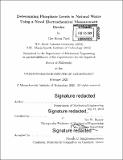| dc.contributor.advisor | Ian W. Hunter. | en_US |
| dc.contributor.author | Park, Gee Hoon. | en_US |
| dc.contributor.other | Massachusetts Institute of Technology. Department of Mechanical Engineering. | en_US |
| dc.date.accessioned | 2020-09-25T20:05:14Z | |
| dc.date.available | 2020-09-25T20:05:14Z | |
| dc.date.copyright | 2020 | en_US |
| dc.date.issued | 2020 | en_US |
| dc.identifier.uri | https://hdl.handle.net/1721.1/127729 | |
| dc.description | Thesis: Ph. D., Massachusetts Institute of Technology, Department of Mechanical Engineering, 2020 | en_US |
| dc.description | Cataloged from PDF of thesis. | en_US |
| dc.description | Includes bibliographical references (pages 157-177). | en_US |
| dc.description.abstract | Current measurement of the phosphorus level in natural water are based on the phosphomolybdenum blue (PMB) method. In this method, the phosphate and molybdate ion form 12-molybdophosphoric acid (12-MPA) which is reduced to yield intensely coloured PMB, and its intensity is correlated with the phosphate concentration using spectrophotometry. Despite its well-established sensitivity and selectivity to the phosphate ion, commercially available in situ portable measurement devices suffer from their large footprints and limited working time. This is mainly because the wet chemistry of the PMB method requires a constant supply of liquid reagents of which volume determines the footprint and working time of the device. Such limitations of the existing methods make it difficult to access the temporal and spatial information of the phosphorus level in natural water which is crucial in the control of eutrophication. | en_US |
| dc.description.abstract | In this thesis, we designed, fabricated, and evaluated two novel electrochemical phosphate detection devices that offer unique opportunities to be developed into portable, in-situ, and automated phosphate detection devices. The detection of phosphate is based on the formation of 12-MPA, wherein reagents are supplied in situ by the anodic dissolution of molybdenum (Mo). The first version of the device with two Mo electrodes in two separate chambers demonstrated that reducing the sample volume of the device reduces the time of detection and the energy consumption per measurement based on the Mo oxidation, when compared to the current state of the art (2 min and 900 mJ versus 70 min and 18 J, respectively). The second version device is improved further by simplifying the system into a single chamber with a single Mo electrode, which additionally decreases the response time to 30 s and the energy consumption to 4 mJ. | en_US |
| dc.description.abstract | The experimental results with these two devices demonstrate the capability of phosphate determination (0.1 to 25 pM) in a high conductivity background solution (0.1 M NaCl), such as seawater, without significant interference from silicate ions. In addition, the second version of the device broadens its application into other types of natural water with low conductivity, and provides a promissing possibility to be further developed into an open-cell type sensor. | en_US |
| dc.description.statementofresponsibility | by Gee Hoon Park. | en_US |
| dc.format.extent | 204 pages | en_US |
| dc.language.iso | eng | en_US |
| dc.publisher | Massachusetts Institute of Technology | en_US |
| dc.rights | MIT theses may be protected by copyright. Please reuse MIT thesis content according to the MIT Libraries Permissions Policy, which is available through the URL provided. | en_US |
| dc.rights.uri | http://dspace.mit.edu/handle/1721.1/7582 | en_US |
| dc.subject | Mechanical Engineering. | en_US |
| dc.title | Determining phosphate levels in natural water using a novel electrochemical measurement device | en_US |
| dc.type | Thesis | en_US |
| dc.description.degree | Ph. D. | en_US |
| dc.contributor.department | Massachusetts Institute of Technology. Department of Mechanical Engineering | en_US |
| dc.identifier.oclc | 1196341276 | en_US |
| dc.description.collection | Ph.D. Massachusetts Institute of Technology, Department of Mechanical Engineering | en_US |
| dspace.imported | 2020-09-25T20:05:13Z | en_US |
| mit.thesis.degree | Doctoral | en_US |
| mit.thesis.department | MechE | en_US |
